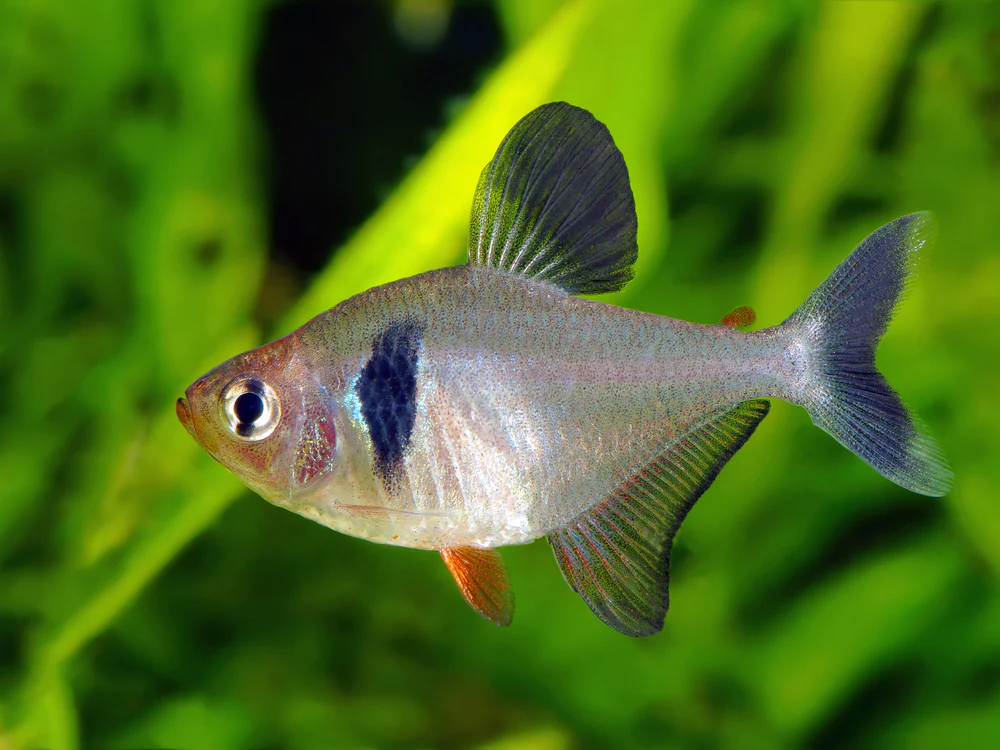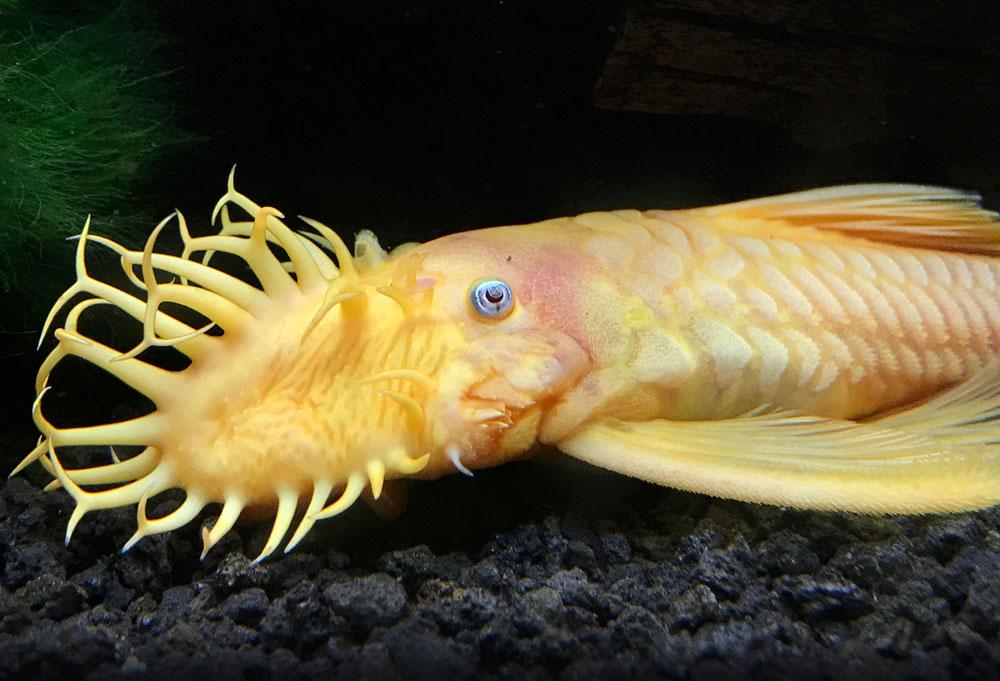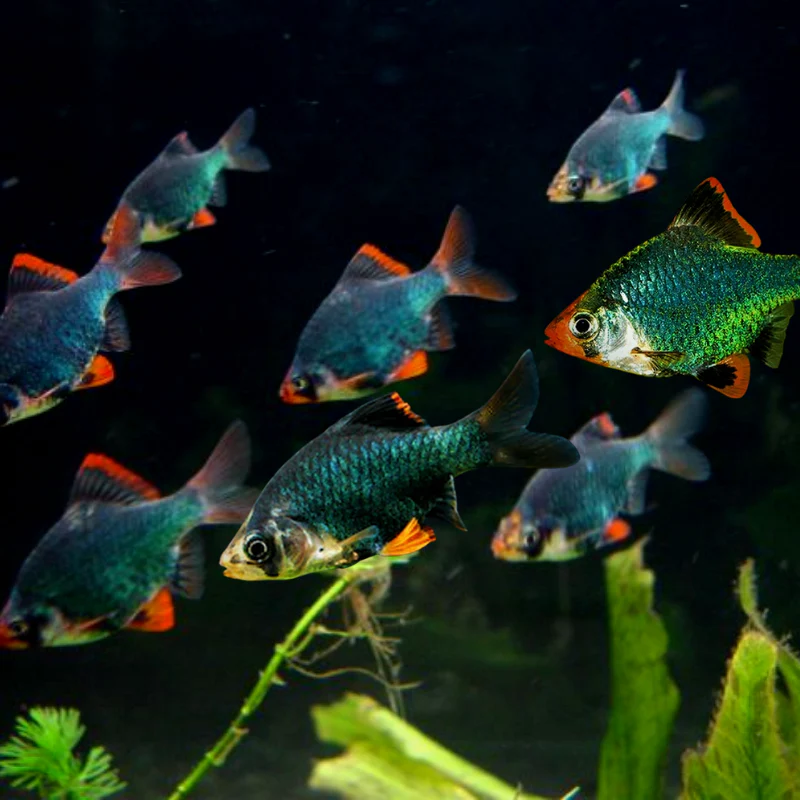Koi have a long and distinctive history as pet fish. Koi originated from the Amur carp (Cyprinus rubrofuscus) which was kept throughout Asia as a food source. Carp can grow quite large very quickly and are hardy fish, making them ideal food sources. However, natural mutations in color occurred throughout countless generations. These fish were separated from the main population and bred together. From cross-breeding these color variations over centuries, the koi we know today emerged.
These ornamental fish were bred with a scaleless carp imported into Japan from Germany and spawned a mutation of scaleless koi. Known as “doitsu,” or “German” in Japanese, these koi are very popular due to the shiny smooth appearance of their skin. They may have a few scales, called a “zipper,” along both sides of their dorsal fin, haphazardly placed across their body, or just a few overlapping giant scales on their sides.
Some koi, known as butterfly or long-fin koi, have elongated fins throughout their body. These fins are prone to tears and scarring, so be sure their environment has limited snags to preserve their flowing fins.
Koi are found today throughout the world. There are high-status markets in Japan that carry the world’s most ornate and expensive fish, selling for thousands of dollars each! Many koi kept today are domestic-bred koi that do not carry a high price tag but are beloved pets, just like any other fish.
Colors and Markings
Koi have numerous classifications and color specifications. There can be many minute differences in color that move fish between one class or another. Here are some of the more popular colorations.
:strip_icc():format(webp)/GettyImages-519918238-0a222d83642543a3b84dd525f3d46491.jpg)
The Gosanke (The Big Three)
Comprised of the kohaku, sanke, and showa, these koi are the most prized and most valuable throughout the koi hobby. They are often the top show winners at koi shows across the globe.
Kohaku
The kohaku variety of koi is a white body with red pigmentation. There are many patterns within the kohaku variety that contribute to their worth. For classic kohaku koi, the red or “hi” pigment must be deeply saturated and conform to the scale edges, creating a sharp contrast in white and red areas. It is best if all the red pigment is joined in bands or large spots across the body without random scattering of pigment.
Sanke
Sanke means “tri-colored,” and is a kohaku coloration with black or “sumi” marks. There should be no black marks on the head, but red pigment is okay. It is preferred if the fins have some black stripes throughout for contrast.
Showa
The showa koi is similarly related to the sanke. Showa koi possess the same coloration of white, red and black, but showa koi have more black pigment than red, creating a vibrant contrasting pattern. The black can extend onto the head and on the bases of the fins.
Bekko
A bekko koi can be many different body colors with black marks along their backs. A Shiro Bekko has a white body, a Ki Bekko has a yellow body, and an Aka Bekko has a red body.
Kawarimono
This collection of koi varieties is divided further still. This group contains the Shiro Muji (pure white), Karasugoi (all black), Goshiki (a mix of all five colors—white, red, black, blue, and dark blue), Chagoi (brown), Benigoi (all red), Kigoi (all yellow) and many others.
Pondmates
The most important aspect of keeping fish in outdoor ponds is that they are subject to the elements and outdoor temperatures. You can try to heat your pond, but if your heater ever fails, warmer fish species will get sick very quickly. It is not recommended to keep tropical fish, including the plecostomus, in outdoor ponds in cold weather.
Additional Koi
Before filling your pond to the brim, keep in mind that you will require at least 250 gallons of water per koi. Sure they may not need this when they are small, but when they grow up, they sure will need the extra space. Pregnancy, breeding female koi should have 500 gallons each in order to have enough energy to rear their egg masses. Koi are communal fish, so at least 3 koi per pond are preferred.
Goldfish
It is a complete myth that koi and goldfish cannot be kept together. They are essentially carp “cousins” and share all the same diseases. Goldfish do not need as much room as koi, so some ponds may be better as goldfish ponds, rather than stunting koi in a tiny pond.
Hi-Fin Sharks
A newer addition to the fish hobby, the High-Fin Shark (Myxocyprinus asiaticus) do well in outdoor ponds. Another carp cousin, these fish are more herbivorous, so they may help cut back on some of the algae in your pond, but they certainly prefer koi pellets. These fish can also grow very large and their dark color makes them harder to see in the pond.
Aquatic Turtles
Turtles can be added to ponds with extreme caution. Some turtles get along with fish and do not cause any issues. Naughty turtles will bite koi on their fins and operculum, causing serious damage and disease.
Koi Habitat and Care
The biggest consideration in building and maintaining a koi pond is having enough room for all your fish. Although they start very small, most koi can grow over 24″ long in a few, short years. Many owners make the mistake of overstocking their pond when their fish are small and then have to get rid of fish when they outgrow their surroundings. Koi should never be kept in a tank unless the tank is at least 500 gallons or more.
All koi ponds must have at least 250 gallons per fish. This may sound ridiculous when your fish is only a few inches, but they’ll need it when they grow up. More water will always make maintenance easier and keep your fish healthier.
Koi ponds can vary widely in temperature. Koi can tolerate a wide range of temperatures but are easily stressed when temperatures change very quickly. Insulate the sides of your pond, dig your pond to a depth of 24″-48” or more, and provide shade cover to protect your fish from sudden temperature fluctuations.
Since koi ponds are typically kept outside and host very large fish, your filtration system must be well-planned and correctly installed. There are three different types of filtration common in koi ponds: mechanical, chemical, and biological.
Koi Diet and Feeding
Koi, like their goldfish cousins, are bottom-feeding omnivores. They eat a lot of bugs and spend lots of time foraging in the substrate. Most koi diets are floating diets, allowing owners to see their fish during feeding time, and most koi adapted well to feeding at the surface. Many owners will see their fish nibbling on algae and assume they like their veggies, but this is not the case. Bugs and bug larvae take up residence in algae and this is much tastier for your fish than boring green algae. Koi are omnivores, though, and will eat lettuce and other leafy greens added to the pond.
There are many commercial koi diets available, and price has no correlation to a food being “better” than any other. Many koi diets are sold for specific seasons, but you don’t have to switch your koi diet each season. Store all fish food inside in an airtight container and replace it every 6 months to ensure the water-soluble vitamin content, including vitamin C, stays within healthy levels.
Given their outdoor status, koi appetites will vary depending on their water temperature. In some climates, koi may not be interested in eating at all or eating very little for months during cold weather. This is a normal behavior and is not any cause for alarm. As temperatures warm, fish will return to their normal appetites.




Reviews
There are no reviews yet.